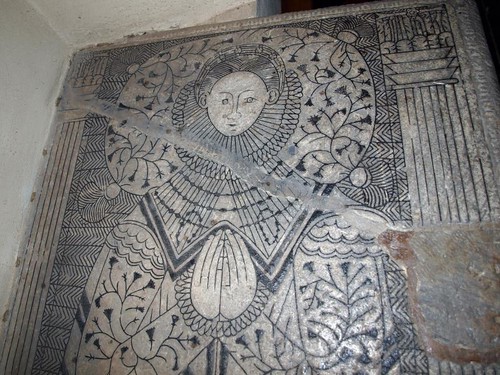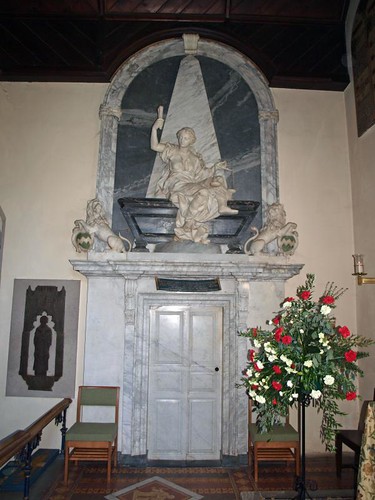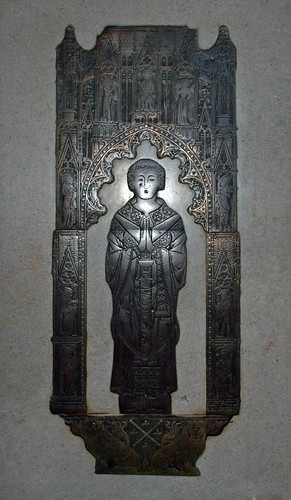The three best features are John, Lord Somers' Peter Scheemakers monument which incorporates a marble door to the vestry (which used to be the entrance to the family vault), the C14 Flemish Kesteven brass and, to me, best of all the Beresford tomb - a late C16, Derbyshire alabaster altar tomb, with a scratch portrait, outlined in bitumen, of a lady, lettering on the edge and coats-of arms and columns at the sides. The style of this tomb cover is very unusual, and demonstrates the dress of the period. Records state that this is a memorial to two sisters, Elizabeth & Mary, who died in 1584.
It made me wonder if the only other example I've seen of this type of monument, Alice Tyrell d. 1422 at East Horndon in Essex, might once have been also have been outlined in bitumen; it would make sense since the bitumen pulls out the detail on the Beresford tomb while Dame Alice is indistinct by comparison.
ST MARY. In North Mimms Park, yet not near the house. The Vicarage of the late C17 close to the church, also in the park. The church has an interesting C14 building history. At the beginning of that century the chancel seems to have existed; in 1328-29 a N chapel was added with 2-light simple Dec tracery, and a N aisle with windows of three lights but the same reticulated tracery. The S aisle is nearly contemporary, as proved by the identical octagonal piers of the (3-bay) arcades with their moulded capitals and double-chamfered arches. A S chapel must also have been intended; for a blocked arch appears at the E of the aisle. But closer examination of the (triple-chamfered) chancel arch reveals on its E side the beginnings of a continuation which can only have been meant for a crossing tower. So the aisles were meant to open into transepts. This ambitious scheme is by no means frequent in C14 parish churches. The W tower (with diagonal buttresses, a C14 W door which has foliage capitals and fleurons in the voussoirs, 2-light bell-openings with transomes, and recessed spire) dates from c. 1440-50. - PULPIT. Elizabethan. One of the panels has a blank pointed arch instead of the usual squat round arches of so much Elizabethan furniture. - PLATE. Chalice c. 1570; covered Cup, c. 1610; German Tankard 1659 (on loan at the British Museum); Flagon, 1707; Paten, 1717. - MONUMENTS. Brass to a priest, c. 1360 with an excellent broad surround with figures in niches. God the Father with the soul of the deceased in a cloth and two angels by his side and in the canopy above the head of the priest. Obviously a Flemish piece. - Brasses to Elizabeth Knowles d. 1458 and two children; a Knight late C15; a civilian and his wife (small figures), late C15; and to Thomas Hewes d. 1587 and wife (all in the chancel). Tomb-chest of the C15 with shields in quatrefoils (Elizabeth Coningsby?). - Tomb-chest of the later C16 with the effigy incised on the lid; flowery pillow, flowery sleeves. - George Jarvis d. 1716, epitaph with gesticulating demi-figure. — John Lord Somers d. 1716, large standing wall monument in the chancel, with marble door at the foot, leading into the vestry. A life-size figure of Justice above against a black obelisk; two lions l. and r.



North Mimms. It luxuriates in the rich possession of three parks: Brookman’s, with the spidery masts of the BBC piercing the sky; Gobion’s, the site of Sir Thomas More’s ancestral home; and the 1000 acres of North Mimms Park, with its noble house and church. In Gobion’s Park stood the old home of the family of Sir Thomas, and when Sir Thomas More’s son John died, 12 years after his father’s execution, Mary Tudor gave the confiscated property to his widow, who gave it to their son Thomas. Thomas, an ardent but secret Roman Catholic, died in 1626, and his two sons (Thomas and Cresacre) succeeded. It is interesting to note that Cresacre wrote the life of his great-grandfather, printing it at Louvain and dedicating it to Queen Henrietta Maria. His grandson sold Gobion’s in 1702. Brookman’s Park is the station from which London wireless programmes are sent out. Its 200-feet aerial masts are seen for miles round Hatfield. The station is on the main road a mile or two south of Hatfield, and in the low buildings which nestle at the foot of the great aerial system are housed two complete transmitters, one for the Regional programme and one for the National, the electric power being supplied by the BBC’s own generating plant operated by oil engines. Transmissions from Broadcasting House come here by post office landlines to be sent out far and wide through the ether.
It was about the year 1600 that the future architect of Hatfield designed the dignified house, North Mimms Park, with its three brick storeys and its fine chimney stacks, its projecting wings and pinnacled gables, and its great mass of transomed windows. The church, reached by a long elm avenue, is older. Begun in the 13th century, to which the chancel belongs, the nave, aisles, and chapel were made new in the 14th, and red-brick patches mark other changes since. The beautiful west doorway was removed from its old wall and built up again when the 15th-century west tower, with its copper spire, was added.
The pulpit, the altar table, and some panelling in the vestry are Jacobean, and the church possesses such a fine 17th-century German tankard of amber and silver that it has been shown at the British Museum. In the chapel built for a chantry about 1328 the light shines through fragments of 15th- and 17th-century glass in the fine old tracery, and falls on the tomb of a 15th-century lady, Elizabeth Coningsby. A Tudor lady, one of the Barfords, is sketched on the flat stone of her alabaster tomb in the aisle, her outline filled in with black.
Above the nave pillars solemn stone faces of medieval folk look down on us, and grotesque heads hold up the roof. A gallery of brass portraits decorates the chancel wall, chief among them the magnificent brass of Thomas de Horton, vicar nearly 600 years ago. Arrayed in his vestments, he stands under a canopy, with Christ and the angels above him and saints at each side, a Flemish masterpiece. The others show an Elizabethan couple (Richard Butler and his wife), Elizabeth Knowles in her fashionable dress of 1458, and an armoured knight and a civilian and his family from the troubled days of the Wars of the Roses. A marble figure of Justice honours a man worthy of honour, for he did more than any other man to establish a constitutional monarchy in England. He was John Somers, who played so great a part in our constitutional history.
On a buttress of the nave is a sundial put up in 1584, eight years after Henry Peacham was born at the rectory. In the British Museum we may see his illustrated translation of King James’s Basilicon Daron, which he did as a present for Prince Henry; it ends with the music and words of the madrigal, Wake softly with singing Oriana sleeping. But his best work was a book entitled The Complete Gentleman, dedicated to a boy of eight and written to urge young men to devote themselves to the arts. Sad to say, his own devotion brought him little profit, and in his old age this painter and engineer was writing books for children and selling them for a penny apiece.
An odd little memory has North Mimms. One September afternoon in 1784. a country woman here was astonished to see a great spherical monster descending from the sky, coming low down near the ground, so near that a man in the car of the balloon was able to hand to her a cat to take care of. He rose again and went on to Standon, where he arrived with a dog; it was Lunardi completing the first successful balloon flight ever known, bringing the first English aerial travellers (a man, a dog, and a cat) down in Hertfordshire.
John Somers, who lies at North Mimms, died Baron Somers of Evesham. He was born near Worcester in 1651, son of a Puritan lawyer. He was a brilliant scholar and linguist, and so distinguished himself at the Bar that the leading counsel for the Seven Bishops insisted on having him at his side.
A man of broad and liberal views, Somers on entering Parliament at once became a force. By convincing the House that James II had abdicated and was no longer king, he made smooth the path of William III to the throne; but he safeguarded the future by framing the masterly Declaration of Rights, a second Magna Carta.
He advocated religious tolerance, and moderation and mercy in State prosecutions; and proved a just judge and a model Lord Chancellor.
With the decline of Whig ascendancy, Somers suffered the common disfavour of his party, and was singled out for vindictive persecution. Two attempts were made to impeach him, one of the counts being that he had promoted and profited by piracy on the high seas. The fact was that Somers had patriotically subscribed towards fitting out a ship to suppress piracy, and that Captain Kidd, appointed to the command, had turned traitor and developed into an arch-pirate himself. A more serious charge was that Somers had been privy to an unconstitutional secret treaty between Dutch William and Louis XIV, proposing the partition of the Spanish dominions by France. Nothing came of the matter, but William was constrained to take the great seal from his Chancellor.
Somers threw the weight of his wisdom and authority on the side of the Union of England and Scotland, and, triumphing over bigotry and interested opposition, secured liberal provisions for the safety of Scottish religion and government.
In April 1716 he died here after a paralytic seizure, honoured and mourned by both parties in the State. He was a great upright counsellor, a fearless champion of public rights, a scholar and a warm friend of learning, the patron of Addison, and the man to whom Swift dedicated his Tale of a Tub. His own writings are contained in the famous Somers Tracts, 13 volumes of scholarship, wise philosophy, and good English.
It was about the year 1600 that the future architect of Hatfield designed the dignified house, North Mimms Park, with its three brick storeys and its fine chimney stacks, its projecting wings and pinnacled gables, and its great mass of transomed windows. The church, reached by a long elm avenue, is older. Begun in the 13th century, to which the chancel belongs, the nave, aisles, and chapel were made new in the 14th, and red-brick patches mark other changes since. The beautiful west doorway was removed from its old wall and built up again when the 15th-century west tower, with its copper spire, was added.
The pulpit, the altar table, and some panelling in the vestry are Jacobean, and the church possesses such a fine 17th-century German tankard of amber and silver that it has been shown at the British Museum. In the chapel built for a chantry about 1328 the light shines through fragments of 15th- and 17th-century glass in the fine old tracery, and falls on the tomb of a 15th-century lady, Elizabeth Coningsby. A Tudor lady, one of the Barfords, is sketched on the flat stone of her alabaster tomb in the aisle, her outline filled in with black.
Above the nave pillars solemn stone faces of medieval folk look down on us, and grotesque heads hold up the roof. A gallery of brass portraits decorates the chancel wall, chief among them the magnificent brass of Thomas de Horton, vicar nearly 600 years ago. Arrayed in his vestments, he stands under a canopy, with Christ and the angels above him and saints at each side, a Flemish masterpiece. The others show an Elizabethan couple (Richard Butler and his wife), Elizabeth Knowles in her fashionable dress of 1458, and an armoured knight and a civilian and his family from the troubled days of the Wars of the Roses. A marble figure of Justice honours a man worthy of honour, for he did more than any other man to establish a constitutional monarchy in England. He was John Somers, who played so great a part in our constitutional history.
On a buttress of the nave is a sundial put up in 1584, eight years after Henry Peacham was born at the rectory. In the British Museum we may see his illustrated translation of King James’s Basilicon Daron, which he did as a present for Prince Henry; it ends with the music and words of the madrigal, Wake softly with singing Oriana sleeping. But his best work was a book entitled The Complete Gentleman, dedicated to a boy of eight and written to urge young men to devote themselves to the arts. Sad to say, his own devotion brought him little profit, and in his old age this painter and engineer was writing books for children and selling them for a penny apiece.
An odd little memory has North Mimms. One September afternoon in 1784. a country woman here was astonished to see a great spherical monster descending from the sky, coming low down near the ground, so near that a man in the car of the balloon was able to hand to her a cat to take care of. He rose again and went on to Standon, where he arrived with a dog; it was Lunardi completing the first successful balloon flight ever known, bringing the first English aerial travellers (a man, a dog, and a cat) down in Hertfordshire.
John Somers, who lies at North Mimms, died Baron Somers of Evesham. He was born near Worcester in 1651, son of a Puritan lawyer. He was a brilliant scholar and linguist, and so distinguished himself at the Bar that the leading counsel for the Seven Bishops insisted on having him at his side.
A man of broad and liberal views, Somers on entering Parliament at once became a force. By convincing the House that James II had abdicated and was no longer king, he made smooth the path of William III to the throne; but he safeguarded the future by framing the masterly Declaration of Rights, a second Magna Carta.
He advocated religious tolerance, and moderation and mercy in State prosecutions; and proved a just judge and a model Lord Chancellor.
With the decline of Whig ascendancy, Somers suffered the common disfavour of his party, and was singled out for vindictive persecution. Two attempts were made to impeach him, one of the counts being that he had promoted and profited by piracy on the high seas. The fact was that Somers had patriotically subscribed towards fitting out a ship to suppress piracy, and that Captain Kidd, appointed to the command, had turned traitor and developed into an arch-pirate himself. A more serious charge was that Somers had been privy to an unconstitutional secret treaty between Dutch William and Louis XIV, proposing the partition of the Spanish dominions by France. Nothing came of the matter, but William was constrained to take the great seal from his Chancellor.
Somers threw the weight of his wisdom and authority on the side of the Union of England and Scotland, and, triumphing over bigotry and interested opposition, secured liberal provisions for the safety of Scottish religion and government.
In April 1716 he died here after a paralytic seizure, honoured and mourned by both parties in the State. He was a great upright counsellor, a fearless champion of public rights, a scholar and a warm friend of learning, the patron of Addison, and the man to whom Swift dedicated his Tale of a Tub. His own writings are contained in the famous Somers Tracts, 13 volumes of scholarship, wise philosophy, and good English.
No comments:
Post a Comment